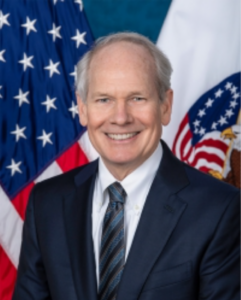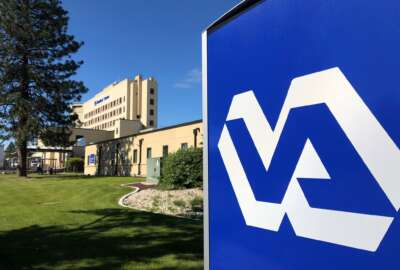VA’s digital transformation is the new CIO’s ‘North Star’ goal
Kurt DelBene, the VA’s assistant secretary for information and technology and chief information officer, said he will push the agency to having a more agile,...
Best listening experience is on Chrome, Firefox or Safari. Subscribe to Federal Drive’s daily audio interviews on Apple Podcasts or PodcastOne.
The Department of Veterans Affairs wants to be a leader in digital transformation for the federal government.
Both the size and scope of the agency, VA leaders believe, gives it a unique opportunity to demonstrate just how change could work.
Kurt DelBene, the VA’s assistant secretary for information and technology and chief information officer, said he plans to build on and accelerate the progress VA has made over the last decade.

“As we begin to do some modernization of our core stack, we are engaged in a huge number of system transformations a colossal number from commercial standards alone. Currently, we’re updating our financial management and logistics systems. We’re enabling support for caregivers through enhancements to our benefit systems. And we’re undergoing transformation of our electronic health record system as well,” DelBene said during a recent discussion with reporters. “Our focus is on innovation and bringing industry best practices and cutting edge technology to the VA. We’re also driving really hard on the having a world class veterans digital experience. We have significantly improved both our veterans’ online customer satisfaction as well as usage, allowing veterans to streamline their health care disabilities and education benefits, payments and other information that impacts their daily lives.”
DelBene doesn’t underestimate the challenge that is in front of him either. VA employees 400,000 doctors, nurses, healthcare professionals, benefit processes, and a host of other professions. It owns nearly 6,300 buildings, which include 1,200 health care facilities, many of which are 60 years old on average.
VA’s IT budget alone is over $8 billion and more than $1 billion in technical debt that will force DelBene to strike a balance of keeping the current technology running and secured, while also modernizing.
“Modernizing is a key challenge that we must face on a daily basis with sustained effort,” said DelBene, who the Senate confirmed in December. “I aspire to bring what I’ve learned to the commercial sector and work with what VA OIT has already done to continue our digital transformation. VA OIT has become a leader not only in the VA, but throughout the federal space. And I want to keep us at the forefront at the foundation. That means working with stakeholders on a clearly articulated vision of what they do to deliver for veterans, caregivers and their families, and then bring that and interpret that into an agenda for our technology innovation. We then need to develop clear plans of action that are agile and adapt as our needs change. We need to have measures of success or metrics that measure end user outcomes. And then our resources need to be clearly allocated based on these priorities in a way that it’s clear how they tick and tie together.”
Deliver benefits to veterans
DelBene is not the first CIO to come to VA with a big vision and set of goals. Over the last 13 years, VA has seen its share of IT executives come in and leave out the door — now four Senate confirmed assistant secretaries and CIOs since 2009 with the average tenure of 18 months.
Congress and other VA customers have decried the inconsistent leadership around technology at the political level. Rep. Matt Rosendale (R-Mont.), ranking member of the Veterans Affairs Subcommittee on IT Modernization, said in October that the inconsistent leadership is one of the main reasons why VA continually struggles with major IT projects.
DelBene, to his credit, seems keenly aware of the challenges VA is facing. This is his second stint in government, working as a senior advisor to the secretary of the Department of Health and Human Services in December 2013 as part of the team to help fix Healthcare.gov. He also was part of the Defense Innovation Board in 2020 and 2021.
“If there’s one thing I hope to hang my hat on at the end of the day, it’s being a part of that transformation. It just delivers benefits across the entire spectrum. What you deliver is more focused. You’re agile and that you respond as needs change. Your resource allocation is better, outcomes are better because they’re tied to what the end user needs. It just delivers benefits across the line,” he said. “That’s where that’s something I think I know a bunch about, and. hopefully as you can tell, it just gets me excited.”
Part of that excitement comes from the progress VA made during the pandemic. The agency proved how agile it could be when implementing new and modern technology, such as expanding and securing its network to handle more than 16 million telehealth visits and moving 400,000 employees to remote work over the last two years.
“We were doing about 40,000 telehealth visits a month, and now we’re doing about 40,000 telehealth visits a day. One other caveat, we’ve quadrupled our bandwidth, and that bandwidth has been built into our sustainment. So we’re counting on that in the out years,” said Todd Simpson, VA’s deputy assistant secretary for development, security and operations. “Just in my limited travels, talking with clinicians and others that work at the medical centers, there is no way culturally they want to step backwards. With some of the technologies that have come out of our Dev/Sec/Ops shop and out of the CTO shop, I don’t think we will. We’ve created some really cool tools that have virtually eliminated the need for a physical waiting room.”
Agile development is the best option
DelBene said the pandemic and other efforts over the last few years has given VA a “North Star” of sorts. He said that means expanding more agile development practices so VA can create new or update applications in a matter of hours or days instead of weeks or months.
He said VA is looking at low code, no code platforms, using more containers to shift applications from one cloud or data center to another, and creating a software factory to oversee all of these efforts.
“The foundation exists within the organization that we just need to ramp up on the whole, having a DevSecOps mentality is a really powerful approach. I think that the team organized around that is the way they deliver solutions. Another one that I think is transformative is we have a very deep investment in security. That’s one of the first places I went when I got here saying, ‘Tell us what your security posture looks like.’ We’re building a modern infrastructure in terms of bringing all of our logging together. So we can do inference across that about potential security threats. I feel good about the foundation, but there’s more that we can do there,” DelBene said. “I think we have a very active cloud migration strategy, which I want to build upon as well. It’s about triaging the portfolio of apps you have and deciding which ones you’re going to modernize which ones you’re going to actually containerize and bring to the cloud. Which ones do you want sunset? I think we can build on that as well.”
VA also already moved 133 applications to the cloud and has another 82 in progress. It still has about 400 in-house developed apps, but the CIO’s office has worked to reduce the use of custom development from 57% in 2019 to 45% in 2021.
Customer experience a primary focus
DelBene also is inheriting a new cyber strategy released in October that outlines five goal areas and dozens of subgoals. VA has struggled to fix long-standing issues ranging from patching to centralized management, to governance and risk management, to a lack of documentation and accounting to fix more than 15,000 plans of actions and milestones. The latest Federal Information Security Management Act (FISMA) report from VA’s inspector general found the Enterprise Cybersecurity Strategy Program (ECSP) is making progress to close gaps and fix problems.
“Cybersecurity is always at the forefront. Protecting the department’s information resources is a critical priority, which includes safeguarding veterans’ information and systems that store process and transmit information. We’re leveraging a balanced risk management approach to do so, just as is done in the industry as well. Here we need to establish clear, clear internal vision for securing the organization leveraging frameworks like zero trust in the NIST framework, while enhancing our compliance with mandates such as FISMA and OMB’s recent regulation 140208,” he said. “Data management and analytics is another key getting to modern data infrastructure with great data management will help us better serve vets and leverage emerging technologies like artificial intelligence algorithms that can create new insights to again help us better serve our customer. Process Automation is also key just as it is in the commercial sector. This includes getting great at process analysis, identifying the key leverage points, and then using great tools such as low code, no code platforms to automate these key processes.”
Underpinning all of these efforts is continuing to improve VA’s customer experience. Over the last 15 years, VA has gone from a 45% customer satisfaction rate to closer to 75% today.
DelBene said he’d like to bring in the concept of a Net Promoter score, which is a way to measure customer experience and predict business growth.
“The Net Promoter score has particular benefits that we like in the industry sector, and I think it has applicability here as well. I mean, at its foundation, though, it’s a little bit like you see an experience and you see what the experience looks like in the consumer space, and then what the experience looks like when you go to VA.gov. The ease of use on consumer basis should be similar,” he said. “There should be a simple login. There should be a pleasant experience that you see first and foremost like here’s the journey map of the things that you can do on this site. We’ll use standard methodologies and then talk to veterans and see what the gaps are and incrementally deliver on those gaps.”
Copyright © 2024 Federal News Network. All rights reserved. This website is not intended for users located within the European Economic Area.
Jason Miller is executive editor of Federal News Network and directs news coverage on the people, policy and programs of the federal government.
Follow @jmillerWFED






